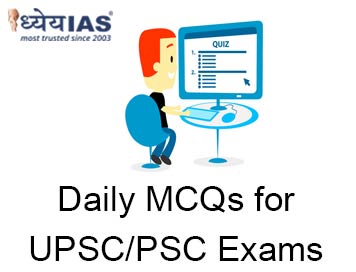Home > Daily-mcqs
Daily-mcqs 03 May 2025

Q1:
Which of the following statements regarding the Chutu dynasty is correct in the context of Deccan epigraphy?
A: They ruled over Tamilakam and were known for Sangam poetry.
B: They were vassals of the Kushanas in the western Deccan.
C: They were a minor ruling house, subordinate or contemporaneous to the Satavahanas.
D: They were patrons of Jain cave architecture in Karnataka.
Answer: C
Explanation:
The Chutu dynasty is believed to have ruled parts of the Deccan, especially Karnataka, and often considered minor or subordinate to the Satavahanas. They are recently mentioned in the Gundaram inscription as Buddhist patrons and allies of Satavahana royalty.
Q2:
With reference to access to antibiotics for drug-resistant infections in India, consider the following statements: Assertion (A): A large number of patients in India with drug-resistant infections do not receive appropriate antibiotic treatment. In the context of the above statements, which one of the following is correct?
Reason (R): India lacks an effective national policy for antibiotic procurement and distribution.
A: Both A and R are correct and R is the correct explanation of A
B: Both A and R are correct but R is not the correct explanation of A
C: A is correct but R is incorrect
D: A is incorrect but R is correct
Answer: B
Explanation:
The assertion is correct because only 7.8% of patients with carbapenem-resistant Gram-negative infections in India received appropriate treatment in 2019, highlighting a serious treatment gap. The reason is also correct—India’s fragmented antibiotic procurement and distribution systems contribute to this problem. However, the reason is not the sole or direct explanation for the poor access. Other factors, such as affordability, lack of awareness, diagnostic delays, and irrational prescription practices, also play significant roles. Therefore, while both the assertion and reason are individually true, the reason does not fully or directly explain the assertion, making option (b) the most accurate choice.
Q3:
With reference to the Shillong–Silchar Greenfield Corridor project, consider the following statements: Which of the above statements is/are correct?
A: 1 only
B: 3 only
C: 1 and 2 only
D: 2 and 3 only
Answer: B
Explanation:
Statement 1 is incorrect because only 22 km of the total 166.8 km corridor lies in Assam, while the majority (144.8 km) is in Meghalaya.
Statement 2 is incorrect as the project is being implemented under the Hybrid Annuity Model (HAM), not EPC.
Statement 3 is correct. The current travel time between Shillong and Silchar is approximately 8.5 hours, and the project aims to reduce it to 5 hours. Thus, only statement 3 is correct.
Q4:
With reference to India’s orange economy, consider the following statements: Which of the above statements is/are correct?
A: 1 only
B: 1 and 2 only
C: 1 and 3 only
D: 1, 2 and 3
Answer: A
Explanation:
India’s Orange Economy encompasses diverse sectors like cinema, music, art, gaming, and handicrafts, highlighting the role of creativity and culture in economic growth. Statement 1 is correct. While the sector is growing at over 10% annually, its current GDP contribution is around 7%, not over 10%—hence statement 2 is incorrect. The sector also includes a large informal workforce, such as artisans and folk artists, making statement 3 incorrect. Therefore, only statement 1 is correct.
Q5:
With reference to plant physiological responses to climate change, consider the following statements regarding T₅₀: How many of the above statements are correct?
A: Only one
B: Only two
C: All three
D: None
Answer: B
Explanation:
T₅₀ is a physiological parameter representing the temperature at which a plant’s photosynthetic efficiency drops by 50%, indicating potential irreversible damage to leaves under heat stress. It is not related to root growth, so statement 1 is incorrect. Statement 2 correctly describes the role of T₅₀ in assessing heat-induced damage. Statement 3 is also accurate—plants with leaf temperatures near their T₅₀ are considered to have a low thermal safety margin, making them more vulnerable to temperature spikes. Therefore, only statements 2 and 3 are correct.